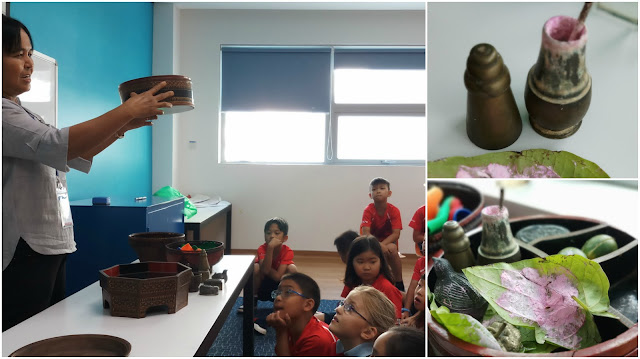Unit of Inquiry: Students began sharing artifacts from their families. We are enjoying seeing students items and learning about their histories and significance.

We had a special guest speaker. Ms Solieng from Early Years, shared some family artifacts that have been in her family for over 70 years. She showed us how Khmer used to make a paste from crushed shells to put inside a leaf and chew for dental hygiene. The students loved hearing her stories.
We had a fabulous trip to the National Museum, where we looked at many sculptures and artifacts that helped us develop our understanding of Cambodia's history.
Some student reflections on our trip:
We began to unpack our understanding of Angkor Wat as an architectural artifact. We will research this more thoroughly next week....looking at what it tells us about Cambodia's past and how it has changed over time. We will become authors on Wiki Junior on this topic. We met Ms Rachel (Diddly Do) this week to discuss the research process we will use. The super 3 will help us remain on track with our learning.
On Friday, we met as a grade to discuss what we will have to do in order to be successful as authors on Wiki Junior. Wiki junior is just like wikipedia, but it is written using language that students can understand. It has only recently been launched, and there is only a tiny bit of information currently on it about Angkor Wat. We decided that as researchers, we could share our understanding with the world using this platform. It is a really authentic way for students to apply and share their understanding. The team co-created success criteria so they know what to do when they research and write about Angkor Wat.
We agreed on 3 'I can' statements to guide us.
I can...plan it, do it, then review it.
I can...tell people where I got the information from.
I can...use words that grade 1-2 students can understand.
Watching the video 'Cambodia 1965' helped us to reflect on how Phnom Penh has changed. Students reflected deeply on the similarities and differences they noticed, and tried to imagine what life would have been like in this city over 50 years ago. Below is the video and some of the student reflections.
Mathematics: We have been working on strategies to assist us when adding and subtracting within 1000. Children have a range of strategies they use to solve problems and model their understanding.
Modeling with place value blocks on a place value chart helps students understand how regrouping works....before they begin to use the 'vertical' strategy we are all familiar with. This video may help clarify how we initially introduce this.
The strategy above models an important understanding students need to develop before they use the vertical way. Once they have secured this knowledge, they can record it more simply using the method below.
The split strategy is popular with the students when solving addition problems. It can be used for subtraction, but can let students down when they encounter problems with regrouping.

Children often use a 'tape diagram' to model their understanding in subtraction.

There are many methods to reach a solution. The emphasis is on students becoming competent modeling their thinking in a way that clearly demonstrates their understanding of number knowledge and place value.
We ended the week with our fun run. It was a great day out!
We were lucky enough to visit the Grade 11 students on Friday. They shared their experiments and findings after examining the waterways of Kep. Students loved the hands on activities and presentations by the senior children.













No comments:
Post a Comment